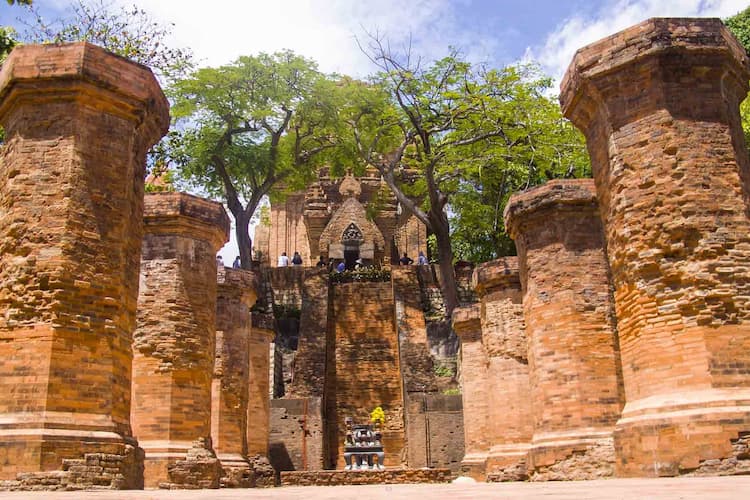
We are reader-supported and may earn a commission on purchases made through links in this article.
If your idea of a wonderful vacation involves treating yourself to tropical warmth, ivory stretches of sand, and the sun’s gentle caress, Nha Trang is the perfect destination.
Located in Khanh Hoa province, about 400 kilometers north of Ho Chi Minh City, Nha Trang first garners global attention for its picturesque scenes. Yet, within this remarkable city, you will embark on a delightful journey to explore its intriguing history, diverse cuisine, and local hospitality—a journey glimpsed at through this article.
Best Tips & Tools to Plan Your Trip
Nha Trang Bay in its Splendor

Nha Trang Bay’s distinctive half-moon shape and topography gift its seawaters with a hue so blue that almost turns turquoise, capturing and refracting every sunbeam. During summertime, the water’s color clarity can be captured naturally on photos and videos without any need for retouching.
Nha Trang has 19 islands, each with differing tropical microclimates and unique charm. As Vietnamese folks like to tell stories through a name, each island is granted a distinctive name: Hòn Mun, Hòn Tằm, Hòn Tre… where “Hòn” means “island” and the following word derives from a characteristic only that island possesses.
Hòn Mun stands out among these islands, taking its name from the distinctive ebony hue of its rocks, with “Mun” meaning jet-black. The rarity of these colored rocks sets this locale apart—a sight rarely seen elsewhere.
Hòn Mun is recognized as a marine biodiversity haven, with approximately 1,500 coral and sea species. The island remains as Vietnam’s sole marine conservation area.

Diving in these waters unveils a whole new wide world. 10 meters below sea surface level, Hòn Mun reveals a spectrum of colorful fish amidst fascinating coral formations. Beyond 18 meters, you can come to explore the deep-ocean caves and other fascinating marine lives thriving in the depths and obscurity.
Meanwhile, Hòn Tằm caters to thrill-seekers, offering a surge of adrenaline in a picturesque canvas. Its name “Tằm”, meaning “silkworm”, is inspired by the island’s silhouette from a bird’s eye view. It also symbolizes growth and prosperity, just like a silkworm brings prosperity and richness through hard work.
The island offers an array of sea activities, including water motor riding, 100-meter parachuting, flying board adventures, coral diving, boating, underwater walking, and even pearl hunting.
A Place of Diverse Heritage

In modern times, the predominant ethnic group in Nha Trang is the Kinh, Vietnam’s largest ethnic group. However, until the 15th century, this land was inhabited by the Cham people.
Their legacy persists in the area’s architecture and spiritual beliefs. For example, Nha Trang’s folks nowadays believe the entire province is under the heavenly guardianship of Po Ina Nagar, whose spirit is said to reside within the Po Nagar Cham Tower.
First built in the 7th century atop a 50-meter hill, the Po Nagar Tower originally comprised three floors. The lowest floor, lost to time, once served as a gate tower. The middle floor, adorned with rows of octagonal columns, was likely a large building for pilgrims to rest and prepare offerings. From here, you will see a steeper set of brick steps leading to the top floor.

Atop these towers, the pinnacle of the architecture unfolds. Inscribed stone slabs portray the elegant Apsara dancers and the divine Shiva. Within these hallowed walls sits the statue of goddess Po Ina Nagar. Carved from marble, she rests upon a lotus, exuding an aura of grandeur that commands reverence and awe.
Long Sơn Pagoda, another impressive architectural attraction in Nha Trang, is renowned for its colossal Golden Buddha, Vietnam’s largest outdoor Buddha statue. Every year, thousands of locals and travelers alike flock to this site, undertaking the challenge of climbing its steps, a journey requiring determination.
The concrete statue rises approximately 14 meters high, seated upon a 7-meter lotus base with a 10-meter diameter. Carved beneath the lotus base are depictions of Thich Quang Duc and six other monks who self-immolated in 1963 to protest the suppression of Vietnamese Buddhism.
Having experienced hundreds of years and numerous repairs and restorations, Long Sơn Pagoda stands as one of Vietnam’s oldest pagodas.
Savor the Feast

Each Vietnamese region has a unique culinary identity. In Central Vietnam, a fondness for seafood and robust flavors is readily found (my family can never survive a dinner without fish sauce reddened by chili). Nha Trang, full of fresh seafood—from baby squid and clams to sea snails, oysters, sea urchins, and even jellyfish—offers a feast for seafood lovers.
But one expects the great lobster would steal the show. Freshly caught from the nearby ocean, its natural sweetness and texture lend themselves perfectly for grilling over charcoal. It goes with many types of condiments, and in those condiments Vietnamese cuisine truly shines—whether it’s butter, mustard, lemon, soy sauce, or fried garlic—each enhancing the lobster’s superior taste.
Although seafood is a must-try, those seeking for a less-crustacean alternative can explore the diversity of local cuisine. While Vietnam’s culinary scene celebrates phở and bún bò as national treasures, Nha Trang locals reserve a special place for a different type of noodles: a petite bowl of bánh canh found in nearly every alley in Nha Trang.
Made from wheat and rice flour, this type of noodle offers a distinct texture—softer and more absorbent, complemented by a broth infused with bone or fish, an assortment of toppings, garnished with fresh spring onion, or fried scallion. The secret lies in the broth—flavorful yet light, sweet with umami but not overwhelmingly fishy.

A culinary rarity is salangane’s nest, with a seemingly unusual ingredient. The dish is made from a local subspecies of swiftlet, who build their nests in dark caves using their own saliva. The locals harvest, clean, and use these nests as a base for many dishes.
The delicacy was once exclusive to the king and aristocracy, now embraced by a wider audience, not only for its inherent flavor but for its nutritional benefits. Vietnam’s most esteemed bird’s nest brand, Sanest Khanh Hoa, originates from Nha Trang.
Nha Trang Awaiting You

Compared to other cities in Vietnam, Nha Trang is rather small, one-eighth the size of Ho Chi Minh City and one-eighteenth of its population. As a result, Nha Trang offers a refreshing contrast. Bustling traffic jams and overcrowded streets are a rarity. The locals are homely, friendly, and—perhaps influenced by the gentle sea breeze—enjoy a leisurely life rarely disrupted by anything.
Nha Trang provides numerous accommodation options. There are many renowned hotels with breathtaking sea views like Mường Thanh, Novotel, InterContinental Nha Trang, Sheraton Nha Trang, and Lodge…
However, if you prefer a more homely atmosphere, a variety of homestays are found a block or two away from the beach. You should book a hotel in advance, especially in the high season (July and August).
Nha Trang strikes a balance between modernity and local charm. While you can find some international food chains and many youngsters speak English fluently, the city still retains its authentic touch through local food vendors and the warm welcome of locals greeting foreigners with bright smiles. This is just the beginning—an invitation to experience all that Nha Trang has to offer.
If You Go:
https://www.lonelyplanet.com/vietnam/south-central-coast/nha-trang
https://vietnam.travel/places-to-go/central-vietnam/nha-trang
Inspire your next adventure with our articles below:
Author Bio: Spencer Vo, a freelance writer, is driven by an insatiable curiosity for culture, languages, cuisine and history. Born and growing up in Vietnam, she takes immense pride in sharing her homeland’s rich narrative with the global audience.

